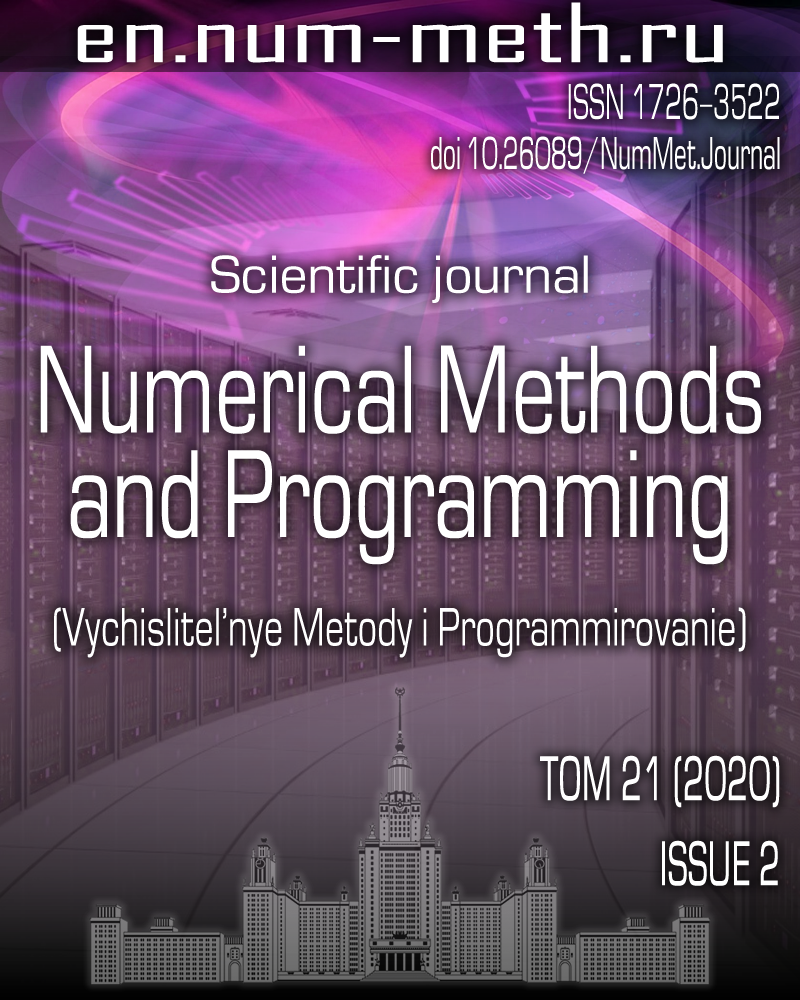DOI: https://doi.org/10.26089/NumMet.v21r212
A software package for the mathematical simulation of fracture in a thermo-poroelastic medium
Keywords:
Abstract
A software package for the mathematical simulation of thermo-poroelastic medium evolution with damage is considered. The employed model is a modification of the Biot model for thermo-poroelastic media and allows one to simulate the changes in the stress-strain state of the medium, the fluid flows, the nonisothermic effects, and the medium fracture. The medium damage is simulated using the continuum damage mechanics approaches by introducing a special variable called the damage parameter. This parameter characterizes the degree of medium fracture and its evolution is described by a given kinetic equation. The numerical algorithm is based on a finite element method. The time discretization is performed using an implicit scheme for displacements, pressure, and temperature and an explicit scheme for the damage parameter. The Taylor-Hood finite elements of second-order approximation in displacements and first-order approximation in pressure and temperature are chosen. The system of equations is solved in the framework of the "monolithic" formulation without the iterative coupling between groups of equations. The numerical results of solving the problem on the rock damage evolution due to thermal action are discussed.
Published
Issue
Section
References
- D. Krajcinovic and G. U. Fonseka, “The Continuous Damage Theory of Brittle Materials, Part 1: General Theory,” J. Appl. Mech. 48 (4), 809-815 (1981).
- S. Murakami, Continuum Damage Mechanics: A Continuum Mechanics Approach to the Analysis of Damage and Fracture (Springer, Dordrecht, 2012).
- V. I. Kondaurov and V. E. Fortov, Fundamentals of the Thermomechanics of a Condensed Medium (Moscow Inst. Phys. Technol., Moscow, 2002) [in Russian].
- M. A. Biot, “General Theory of Three Dimensional Consolidation,” J. Appl. Phys. 12 (2), 155-164 (1941).
- W. Noll, “A Mathematical Theory of the Mechanical Behavior of Continuous Media,” Arch. Ration. Mech. Anal. 2 (1), 197-226 (1958).
- A. A. Griffith, “The Phenomena of Rupture and Flow in Solids,” Phil. Trans. R. Soc. London, Ser. A. Vol. 221, 163-198 (1920).
- L. M. Kachanov, “Rupture Time under Creep Conditions,” Izv. Akad. Nauk SSSR, Otdel Tekh. Nauk, No. 8, 26-31 (1958) [Int. J. Fract. 97, 11-18 (1999)].
- Yu. N. Rabotnov, “On the Mechanism of Long-Term Fracture,” in Problems of Strength of Materials and Structures (Izd. Akad. Nauk SSSR, Moscow, 1959), pp. 5-7.
- A. S. Meretin and E. B. Savenkov, Mathematical Model for Coupled Flow and Damage in Thermoporoelastic Medium , Preprint No. 58 (Keldysh Institute of Applied Mathematics, Moscow, 2019).
- J. Kim, H. A. Tchelepi, and R. Juanes, “Stability, Accuracy, and Efficiency of Sequential Methods for Coupled Flow and Geomechanics,” SPE J. 16 (2011).
doi 10.2118/119084-PA - C. Taylor and P. Hood, “A Numerical Solution of the Navier-Stokes Equations Using the Finite Element Technique,” Comput. Fluids 1 (1), 73-100 (1973).
- F. Brezzi and M. Fortin, Mixed and Hybrid Finite Element Methods (Springer, New York, 1991).
- Y. Saad, Iterative Methods for Sparse Linear Systems (SIAM, Philadelphia, 2003; Mosk. Gos. Univ., Moscow, 2013).
- S. P. Neuman, “Saturated-Unsaturated Seepage by Finite Elements,” J. Hydraul. Div. 99 (12), 2233-2250 (1973).
- E. Cuthill and J. McKee, “Reducing the Bandwidth of Sparse Symmetric Matrices,” in Proc. 24th ACM Nat. Conf., New York, USA, August 26-28, 1969 (ACM Press, New York, 1969), pp. 157-172.
- C++ Template Library for Linear Algebra.
http://eigen.tuxfamily.org . Cited March 19, 2020. - HYPRE: Scalable Linear Solvers and Multigrid Methods.
https://computation.llnl.gov/projects/hypre-scalable-linear-solvers-multigrid-methods . Cited March 19, 2020. - ParaView.
https://www.paraview.org . Cited March 19, 2020. - Visualization Toolkit (VTK).
https://www.vtk.org . Cited March 19, 2020. - J. Pogacnik, M. O’Sullivan, and J. O’Sullivan, “A Damage Mechanics Approach to Modeling Permeability Enhancement in Thermo-Hydro-Mechanical Simulations,” in Proc. 39th Workshop on Geothermal Reservoir Engineering, Stanford, USA, February 24-26, 2014 (Stanford Univ. Prss, Stanford, 2014),
https://pangea.stanford.edu/ERE/pdf/IGAstandard/SGW/2014/Pogacnik.pdf . Cited March 19, 2020. - C. A. Tang, L. G. Tham, P. K. K. Lee, et al., “Coupled Analysis of Flow, Stress and Damage (FSD) in Rock Failure,” Int. J. Rock Mech. Min. 39 (4), 477-489 (2002).
- H. D. Beggs and J. R. Robinson, “Estimating the Viscosity of Crude Oil Systems,” J. Pet. Technol. 27 (9), 1140-1141 (1975).
- F. Sun, P. Jia, and S. Xue, “Continuum Damage Modeling of Hydraulic Fracture from Perforations in Horizontal Wells,” Math. Probl. Eng. (2019).
doi 10.1155/2019/9304961


